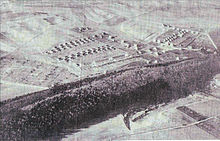Birnbaumskamp
The Birnbaumskamp is a street in the Moritzberg district in Hildesheim . It formed the first suburban settlement in Hildesheim.
history
On November 18, 1921, 24 applicants who had been drawn were each given about one Hanoverian acre (2,621 m²) of land with the conclusion of an 80-year leasehold contract in the Birnbaumskamp estate. Before this area was arable land and belonged to the Johannishof Foundation .
In the beginning, the area was only made accessible through poorly paved dirt roads. The settlers had no claim to the expansion of these roads to regular roads from the city, this only happened ten years later in a rather makeshift form.
The first tenants began to build in the summer of 1922 . Most of the homes were built as semi-detached houses and the first building material consisted of stones from a dismantled brick factory and a demolished barracks courtyard wall . The financing was sometimes only possible with considerable economic hardship, especially since billions for materials and craftsmen had to be paid in billions and billions for a number of buildings during the inflationary period .
The large plots of land for growing fruit and vegetables as well as the stables for domestic and small animal breeding provided at each house were intended to support the families' self-sufficiency, as only applicants with low incomes were considered when the land was awarded.
In 1924, the settlers had to pay 370 Reichsmarks per system for the street lighting (three lanterns) they applied for and put “a sturdy oak post” for the post box. Back then there were already two empties a day. A “public reporting point for fire, water and accidents” was initially the only telephone system on Birnbaumskamp. Water only came from our own well. The toilets were emptied into brick pits, whose manure partly on the compost came, was another part pumped out by a company. A water pipe was not laid until 1930 when the later settlements of Nonnenkamp and Glockenfeld were opened up. Sewers were only created in the early 1950s. Until autumn 1925, the municipal power station supplied direct current , which was then converted to alternating current .
The companies "Bartels & Rempen" and "Frost" took over the supply of food. Both had their business on the Moritzberg. Every day they sent their apprentices to take orders and deliver the groceries. The milk came from Marienrode Abbey , and from 1926 a baker delivered fresh bread to the front door every day. Ice cream came every summer - and a beer cart . There was also a butcher and a small mom and pop shop .
The settlers were exempt from dog tax in the early days , as dogs were recognized as guard dogs in the lonely area . Every homeowner had a whistle to alert the neighbors in case of danger.
As different as the political attitudes of the settlers were during the Weimar Republic , the good neighborly relationship was never tarnished. When it came to their settlement and their rights, the residents were united. So they were able to assert themselves against the city even after a lengthy process when the city suddenly wanted to double the ground rent .
today
After the plot of land and new buildings have been divided up, more than 80 parties now live on the same area, which at the time was just 30 families. Most of the orchards and vegetable gardens have given way to lawns and ornamental gardens. Chickens , ducks , rabbits , pigs , sheep and goats have almost completely disappeared - but there are all the more dogs and cats . There are no more shops.
Web links
- Birnbaumskamp settlement: “Don't worry about us” . In: Moritz vom Berge 179 (December 2007)
Coordinates: 52 ° 8 ′ 15 " N , 9 ° 55 ′ 29.4" E

